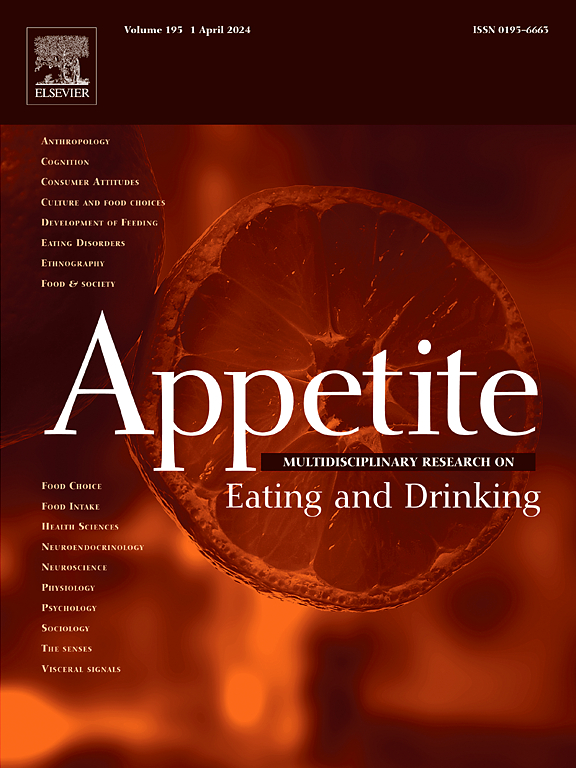社会观念走向在线:探索社交媒体食品内容曝光对食品规范观念的影响。
IF 4.6
2区 医学
Q1 BEHAVIORAL SCIENCES
引用次数: 0
摘要
社交媒体正在成为一个越来越重要的食物相关内容的环境,然而,社交媒体上遇到的食物内容是否有助于感知与食物相关的社会规范的问题相对未被探索。在本研究中,我们通过测试在YouTube上接触不健康食品内容是否与人们如何看待有关(非)健康食品消费的社会规范有关来解决这个问题。此外,我们研究了曝光与规范感知之间假设联系的边界条件,重点关注内容类型(即广告与用户生成内容)和个人特征(即算法媒体内容意识)。我们采用了数据捐赠的方法来收集YouTube上用户接触食物相关内容的数据,并将其与调查相结合。根据102名受访者的数据,不健康食品含量暴露(即频率和比例)与感知到的不健康食品规范之间没有显著关联。然而,探索性分析显示,不健康食品内容暴露(即频率)与感知到的健康食品规范之间存在显著的负相关,当个人遇到更多用户生成的食品内容(与食品广告相比)时,这种关联更为明显。有趣的是,这种模式只出现在禁令规范中,而不出现在描述性规范中。尽管这些结果对暴露于不健康食品含量与食品规范认知之间的假定联系提供了有限的支持,但这些发现为该领域的未来研究提供了输入。本文讨论了本研究的局限性和采用数据捐赠方法探索社交媒体数据的意义。本文章由计算机程序翻译,如有差异,请以英文原文为准。
Social perceptions going online: Exploring the impact of social media food content exposure on perceptions of food norms
Social media is becoming an increasingly important environment for food-related content, however, the question of whether the food content encountered on social media contributes to the perception of food-related social norms is relatively unexplored. In the present study, we addressed this question by testing whether exposure to unhealthy food content on YouTube is related to how people perceive social norms regarding (un)healthy food consumption. Furthermore, we investigated the boundary conditions for the hypothetical link between the exposure and the norm perceptions, focusing on the type of content (i.e., ads vs. user-generated content) and individual characteristics (i.e., algorithmic media content awareness). We applied a data donation approach to collect YouTube data on users' exposure to food-related content and combined this with a survey. With the data from 102 respondents, no significant association between unhealthy food content exposure (i.e., frequency and proportion) and perceived unhealthy food norms was found. Explorative analyses revealed, however, a significant negative association between unhealthy food content exposure (i.e., frequency) and perceived healthy food norms, and this association was more pronounced when individuals encountered more user-generated food content (vs. food ads). Interestingly, this pattern emerged only for injunctive norms but not for descriptive norms. Despite these results offering limited support for the presumed link between exposure to unhealthy food content and food norm perceptions, the findings provide input for future studies in this area. Limitations of the present study and implications of employing a data donation approach for exploring social media data are discussed.
求助全文
通过发布文献求助,成功后即可免费获取论文全文。
去求助
来源期刊

Appetite
医学-行为科学
CiteScore
9.10
自引率
11.10%
发文量
566
审稿时长
13.4 weeks
期刊介绍:
Appetite is an international research journal specializing in cultural, social, psychological, sensory and physiological influences on the selection and intake of foods and drinks. It covers normal and disordered eating and drinking and welcomes studies of both human and non-human animal behaviour toward food. Appetite publishes research reports, reviews and commentaries. Thematic special issues appear regularly. From time to time the journal carries abstracts from professional meetings. Submissions to Appetite are expected to be based primarily on observations directly related to the selection and intake of foods and drinks; papers that are primarily focused on topics such as nutrition or obesity will not be considered unless they specifically make a novel scientific contribution to the understanding of appetite in line with the journal's aims and scope.
 求助内容:
求助内容: 应助结果提醒方式:
应助结果提醒方式:


